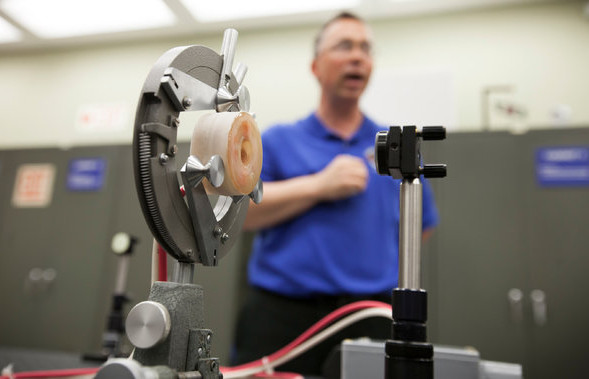NASA Physicists Working on Warp Drive Technology For Travel Faster Than the Speed of Light
If you possess the unique combination of characteristics that allow you be both incredibly precise and focused on specific physics problems yet daydreamy enough to stare up at the night sky and wonder “What if?”, you might work for NASA, and you might also be Harold G. White, a NASA physicist who’s researching the possibilities of warp drive travel. (That is, faster than the speed of light.)
White has been researching warp travel in a NASA lab, attempting to warp the trajectory of a photon and thus change the distance it travels within a defined area. White’s team is measuring any change with a highly sensitive interferometer in a “floating” lab built on pneumatic piers to prevent earthly vibrations from affecting the tests.

Credit: NYT
Basically, warp speed could theoretically be possible if a spaceship was simultaneously pulled toward an object in space (eg, a star) and pushed away from Earth using a “warp bubble”; this actually jibes with the fact that space has been expanding ever since the Big Bang, which indicates that the very fabric of space and time is stretchable.
Of course, warp speed has myriad problems before it could ever become a reality. There’s the simple problem of generating enough energy for that sort of propulsion, the need for a lot of “exotic matter” that doesn’t obey typical laws of physics, and the issue of how one might turn a warp drive on or off.

Credit: NYT
It’s something of a moonshot, and everyone involved assents to the fact that if warp speeds are possible at all, we won’t see the technology come into being for a very long time. Still, humans have accomplished other feats that to a person in the not-too-distant past would seem equally implausible.
We landed on the moon, for instance. Jets crisscross oceans and continents every day, and the most notable thing about it is the lack of leg room. We can now video chat with people on the other side of the world on our phones. And so on.
So yes, the notion of a warp drive at all, let alone one that’s practical to use, seems completely impossible, but hey--what if?
White has been researching warp travel in a NASA lab, attempting to warp the trajectory of a photon and thus change the distance it travels within a defined area. White’s team is measuring any change with a highly sensitive interferometer in a “floating” lab built on pneumatic piers to prevent earthly vibrations from affecting the tests.

Credit: NYT
Basically, warp speed could theoretically be possible if a spaceship was simultaneously pulled toward an object in space (eg, a star) and pushed away from Earth using a “warp bubble”; this actually jibes with the fact that space has been expanding ever since the Big Bang, which indicates that the very fabric of space and time is stretchable.
Of course, warp speed has myriad problems before it could ever become a reality. There’s the simple problem of generating enough energy for that sort of propulsion, the need for a lot of “exotic matter” that doesn’t obey typical laws of physics, and the issue of how one might turn a warp drive on or off.

Credit: NYT
It’s something of a moonshot, and everyone involved assents to the fact that if warp speeds are possible at all, we won’t see the technology come into being for a very long time. Still, humans have accomplished other feats that to a person in the not-too-distant past would seem equally implausible.
We landed on the moon, for instance. Jets crisscross oceans and continents every day, and the most notable thing about it is the lack of leg room. We can now video chat with people on the other side of the world on our phones. And so on.
So yes, the notion of a warp drive at all, let alone one that’s practical to use, seems completely impossible, but hey--what if?

